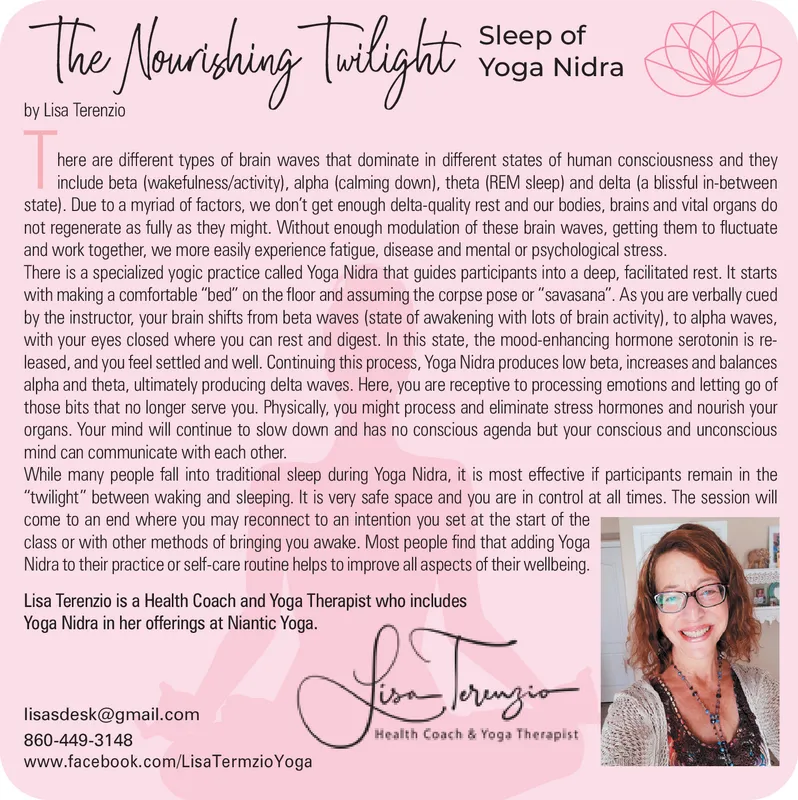Advertisement

-
Published Date
May 5, 2022This ad was originally published on this date and may contain an offer that is no longer valid. To learn more about this business and its most recent offers, click here.
Ad Text
The Nourishe ing Talight Sleep of Yoga Nidra by Lisa Terenzio here are different types of brain waves that dominate in different states of human consciousness and they include beta (wakefulness/activity), alpha (calming down), theta (REM sleep) and delta (a blissful in-between state). Due to a myriad of factors, we don't get enough delta-quality rest and our bodies, brains and vital organs do not regenerate as fully as they might. Without enough modulation of these brain waves, getting them to fluctuate and work together, we more easily experience fatigue, disease and mental or psychological stress. There is a specialized yogic practice called Yoga Nidra that guides participants into a deep, facilitated rest. It starts with making a comfortable "bed" on the floor and assuming the corpse pose or "savasana". As you are verbally cued by the instructor, your brain shifts from beta waves (state of awakening with lots of brain activity), to alpha waves, with your eyes closed where you can rest and digest. In this state, the mood-enhancing hormone serotonin is re- leased, and you feel settled and well. Continuing this process, Yoga Nidra produces low beta, increases and balances alpha and theta, ultimately producing delta waves. Here, you are receptive to processing emotions and letting go of those bits that no longer serve you. Physically, you might process and eliminate stress hormones and nourish your organs. Your mind will continue to slow down and has no conscious agenda but your conscious and unconscious mind can communicate with each other. While many people fall into traditional sleep during Yoga Nidra, it is most effective if participants remain in the "twilight" between waking and sleeping. It is very safe space and you are in control at all times. The session will come to an end where you may reconnect to an intention you set at the start of the class or with other methods of bringing you awake. Most people find that adding Yoga Nidra to their practice or self-care routine helps to improve all aspects of their wellbeing. Lisa Terenzio is a Health Coach and Yoga Therapist who includes Yoga Nidra in her offerings at Niantic Yoga. orengio lisasdesk@gmail.com 860-449-3148 Health Coach & Yoga Therapist www.facebook.com/LisaTermzioYoga The Nourishe ing Talight Sleep of Yoga Nidra by Lisa Terenzio here are different types of brain waves that dominate in different states of human consciousness and they include beta (wakefulness/activity), alpha (calming down), theta (REM sleep) and delta (a blissful in-between state). Due to a myriad of factors, we don't get enough delta-quality rest and our bodies, brains and vital organs do not regenerate as fully as they might. Without enough modulation of these brain waves, getting them to fluctuate and work together, we more easily experience fatigue, disease and mental or psychological stress. There is a specialized yogic practice called Yoga Nidra that guides participants into a deep, facilitated rest. It starts with making a comfortable "bed" on the floor and assuming the corpse pose or "savasana". As you are verbally cued by the instructor, your brain shifts from beta waves (state of awakening with lots of brain activity), to alpha waves, with your eyes closed where you can rest and digest. In this state, the mood-enhancing hormone serotonin is re- leased, and you feel settled and well. Continuing this process, Yoga Nidra produces low beta, increases and balances alpha and theta, ultimately producing delta waves. Here, you are receptive to processing emotions and letting go of those bits that no longer serve you. Physically, you might process and eliminate stress hormones and nourish your organs. Your mind will continue to slow down and has no conscious agenda but your conscious and unconscious mind can communicate with each other. While many people fall into traditional sleep during Yoga Nidra, it is most effective if participants remain in the "twilight" between waking and sleeping. It is very safe space and you are in control at all times. The session will come to an end where you may reconnect to an intention you set at the start of the class or with other methods of bringing you awake. Most people find that adding Yoga Nidra to their practice or self-care routine helps to improve all aspects of their wellbeing. Lisa Terenzio is a Health Coach and Yoga Therapist who includes Yoga Nidra in her offerings at Niantic Yoga. orengio lisasdesk@gmail.com 860-449-3148 Health Coach & Yoga Therapist www.facebook.com/LisaTermzioYoga
